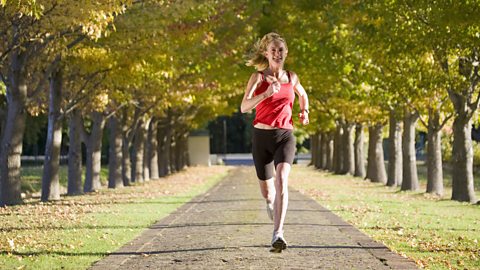Anaerobic respiration
Anaerobic respiration in muscle cells
Human muscle cells can respire anaerobicWithout oxygen. for short periods of time. This often happens during vigorous exercise, such as 100 m sprints. The body struggles to supply the muscles with enough oxygen to keep on doing aerobic respirationRespiration that requires oxygen. but the muscles still need energy to contract. Respiration has to switch to anaerobic. This is relatively inefficient as anaerobic respiration does not make as much ATP, but it's better to continue respiring and have some ATP to allow muscles to contract to run the race, or, in nature, to be able to run away from danger.

Anaerobic respiration in yeast
Anaerobic respiration is economically important - many of our foods are produced by microorganisms respiring anaerobically.
Yeast is used to make alcoholic drinks. When yeast cells are reproducing rapidly during beer or wine production, the oxygen is used up. The yeast has to switch to using anaerobic respiration to ensure it can survive. Ethanol and carbon dioxide are produced.
Yeast can also be used to produce bread. Yeast respires using glucose in the sugar that was added to the dough. Bubbles of carbon dioxide make the bread rise. The alcohol that's produced evaporationThe process in which a liquid changes state and turns into a gas. as the bread is baked.

Anaerobic respiration in plants
Certain plants can also respire anaerobically. These include plants that grow in marshes, where oxygen concentrations will be low. Plant roots that are in waterlogged soil do not have much oxygen available. The root cells therefore carry out anaerobic respiration.

Anaerobic respiration in bacteria
Bacteria can enter the body if a puncture wound occurs. This is a deep wound caused by something sharp and pointed, such as a nail. There is not much oxygen available inside the wound so the bacteria respire anaerobically to get the energy they need to survive.
Where does the glucose for respiration come from?
Plants make their own supply of glucose by using the process of photosynthesisA chemical process used by plants to make glucose and oxygen from carbon dioxide and water, using light energy. Oxygen is produced as a by-product of photosynthesis. Algae subsumed within plants and some bacteria are also photosynthetic.. Plants then use the glucose that they made in the process of respiration.
Animals are consumerAn organism that obtains its energy by eating other organisms.. This means that they eat plants, other organisms or a mixture of both. They have to do this because they cannot make their own glucose. Some of the plant or animal biomassThe dry mass of an organism. that they get by eating is converted into molecules of glucose during digestion. They then use this glucose in respiration.